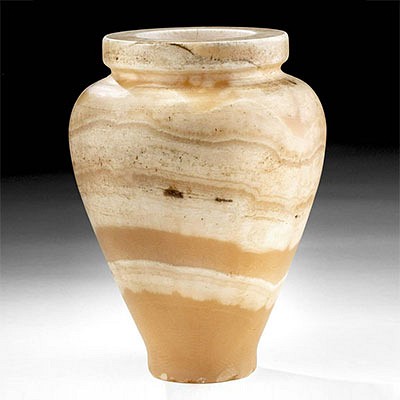Egyptian Ptolemaic Linen Wrapped Mummified Cat w/ X-Ray
Lot 11a
About Seller
Artemis Fine Arts
686 S Taylor Ave, Ste 106
Louisville, CO 80027
United States
Selling antiquities, ancient and ethnographic art online since 1993, Artemis Gallery specializes in Classical Antiquities (Egyptian, Greek, Roman, Near Eastern), Asian, Pre-Columbian, African / Tribal / Oceanographic art. Our extensive inventory includes pottery, stone, metal, wood, glass and textil...Read more
Categories
Estimate:
$4,000 - $6,000
Absentee vs Live bid
Two ways to bid:
- Leave a max absentee bid and the platform will bid on your behalf up to your maximum bid during the live auction.
- Bid live during the auction and your bids will be submitted real-time to the auctioneer.
Bid Increments
| Price | Bid Increment |
|---|---|
| $0 | $25 |
| $300 | $50 |
| $1,000 | $100 |
| $2,000 | $250 |
| $5,000 | $500 |
| $10,000 | $1,000 |
| $20,000 | $2,500 |
| $50,000 | $5,000 |
| $100,000 | $10,000 |
| $200,000 | $20,000 |
About Auction
By Artemis Fine Arts
Dec 17, 2020
Set Reminder
2020-12-17 10:00:00
2020-12-17 10:00:00
America/New_York
Bidsquare
Bidsquare : VARIETY SALE | Antiquities & Ethnographic Art
https://www.bidsquare.com/auctions/artemis-gallery/variety-sale-antiquities-ethnographic-art-6207
Featuring classical antiquities, ancient and ethnographic art from cultures encompassing the globe. Egyptian, Greek, Roman, Etruscan, Near Eastern, Asian, Pre-Columbian, Native American, African / Tribal, Oceanic, Spanish Colonial, Russian, Fossils, Fine Art, more! Artemis Fine Arts info@artemisfinearts.com
Featuring classical antiquities, ancient and ethnographic art from cultures encompassing the globe. Egyptian, Greek, Roman, Etruscan, Near Eastern, Asian, Pre-Columbian, Native American, African / Tribal, Oceanic, Spanish Colonial, Russian, Fossils, Fine Art, more! Artemis Fine Arts info@artemisfinearts.com
- Lot Description
Egypt, Ptolemaic Period, ca. 332 to 30 BCE. A lovely mummified cat of a sizable form bound in delicately woven cotton linens. The roughly ovoid bundle was tightly wrapped at one time, but some wrappings have loosened to expose the neckline and hind legs of the feline. The beige-hued wrappings conceal a beige, brown, and caramel-colored cat that would have had beautiful fur when still alive. Though most of the cat is still present and intact, the original head is missing. This cat was created to evoke Bastet, the cat goddess who represented fertility and motherhood. Thousands of mummified cats and kittens were given as offerings to Bastet at temples in her honor. Beyond the goddess, cats were honored and protected in Egyptian society. Size: 12.875" L x 3.5" W (32.7 cm x 8.9 cm)
The ancient Egyptians, rather uniquely among the world's civilizations, had an obsession with cats, both tame and fierce, large and small. According to Egyptologist Dorothea Arnold, "The earliest Egyptian cats were wild predators that roamed the steppes and marshes. In the refined urban culture of the New Kingdom cats became increasingly attached to humans, who probably first appreciated their mouse-hunting skills but soon came to enjoy these creatures as pleasant companions around the house. Egyptian house cats were considerably larger than modern domesticated cats, which zoologist believe originated in the ancient Near East." (Arnold, Dorothea. "An Egyptian Bestiary." The Metropolitan Museum of Art Bulletin, Spring 1995, Vol. LII, p. 41)
Cats were domesticated to help protect crops from pests in Cyprus or possibly Mesopotamia (it is difficult to interpret the archaeological record on this matter for a variety of reasons), but the Egyptian love of cats seems to have gone above and beyond that of their contemporaries. Egyptians bred millions of animals, including cats, specifically to be mummified and offered to the gods with a prayer, often at yearly festivals centered around temples devoted to animal cults. A. R. Williams, writing in National Geographic in 2009 ("Animals Everlasting"), described these festivals: "Like county fairs, these great gatherings enlivened religious centers up and down the Nile. Pilgrims arrived by the hundreds of thousands and set up camp. Music and dancing filled the processional route. Merchants sold food, drink, and souvenirs. Priests became salesmen, offering simply wrapped mummies as well as more elaborate ones for people who could spend more - or thought they should. With incense swirling all around, the faithful ended their journey by delivering their chosen mummy to the temple with a prayer."
Cf. Malek, Jaromir. "The Cat in Ancient Egypt." University of Pennsylvania Press, Philadelphia, 2006, p. 127, figs. 102-103.
Provenance: ex-estate of Eldert Bontekoe, Pegasi Numismatics, Ann Arbor, Michigan, USA, acquired before 2000
All items legal to buy/sell under U.S. Statute covering cultural patrimony Code 2600, CHAPTER 14, and are guaranteed to be as described or your money back.
A Certificate of Authenticity will accompany all winning bids.
We ship worldwide and handle all shipping in-house for your convenience.
#158160Original head missing as shown by exposed neckline. Fraying, staining, and losses to some linen wrappings, with nicks to some exposed feline bones, and minor staining to original fur color. Great remains of linens and most of cat.Condition
- Shipping Info
-
All shipping is handled in-house for your convenience. Your invoice from Artemis Gallery will include shipping calculation instructions. If in doubt, please inquire BEFORE bidding for estimated shipping costs for individual items.
-
- Buyer's Premium



 EUR
EUR CAD
CAD AUD
AUD GBP
GBP MXN
MXN HKD
HKD CNY
CNY MYR
MYR SEK
SEK SGD
SGD CHF
CHF THB
THB

















